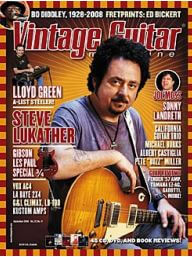
HISTORY TELLS US THAT Leo Fender wasn’t much for “fancifying” things. More meat-and-potatoes than chicken and walnut curry, Leo was a simply guy, and that ethos carried over to the goods produced by his company, whose early amps were covered in tweed or plain black Tolex (for flavor, sometimes brown) and guitars were mostly slabs of wood cut with no fancy arches, curves, routes, or headstock angles.
So it’s no surprise that Fender’s’57 Amp looks nothing like anything created by Leo – and why the company touts it as something he might have built if one day he’d had a little too much coffee, caught a glimpse of a passing Caddy, and suddenly developed an eye for design. We kid, of course….Conceived by Fender industrial designer Shaw Greene and design engineer Nick D’Amato, along with Shane Nicholas, Marketing Director of Fender guitar amps, the ’57 Amp is a limited-edition, hand-wired 1×12”combo that boasts several distinct features that separate it from the company’s standard amps. If you like, call it Fender’s“boutique” amp!
From the fancy, auto-inspired split grille to its piano-black-lacquer finish, knurled control knobs, sleep billet-cut-aluminum “speedboat”handle, the black grille cloth, in terms of aesthetics this is truly a custom unit. Inside, the ’57 Amp sticks to what works – its chassis is the tried and true Fender 5E3(the technical designation for the circuit, referring to its rectifier tube)Deluxe, with top-shelf components and hand-wired construction. One of the darlings of the vintage world,the Deluxe was introduced in1948. It used on 12AX7 and one 12AY7 in its preamp, running into two6V6GC power tubes. The combination delivered some of the most harmonically rich, slightly compressed sounds ever produced by thermionic valves (AKA vacuum tubes). A medium-powered amp, it was designed to give guitarists enough volume to compete with drums and other instruments. And because it so adequately handled virtually any playing style, from clean country background strumming to all-out blues and rock, it has been used by players of all genres.
In the literature and a nicely produced DVD packaged with the ’57Amp, D’Amato talks about listening to vintage ’50s Deluxes and newer clones as they searched for a shining example on which to base the sound of their concept.
For the sake of testing the sounds of the ’57 Amp, what could serve better than a trusty Fender guitar from back in the day – perhaps a ’59Esquire? And for serious head-to-head fun, why not a gen-u-wine Deluxe from ’67? To establish a reference, we first plugged into the ’56. At low volume and playing a traditional bouncy country rhythm on the Esquire, the elder amp offered the trademark uncompressed clean tone that earn edits reputation – big on the bottom, crystal clear on the top. Really nice,and really mellow – fun… for a while. But for most players, the amp starts to groove for real when you take its Volume and Tone controls up to where the 6V6s start to growl (about6). Strumming a second-position G chord (alternating with an open G and D strings for flavor – think“Honky Tonk Women”), the Esquire teams with the amp to give all the“Ahhhh, yeaahhh” tone you could imagine, its stock Jensen P12Qspeaker dancing in the pine cabinet, delivering all of the Deluxe’s 12 punchy watts. Classic, unmistakable, with glorious overtones and just the right amount of gain and compression.
Sitting next to the ’56, the ’57Amplooks shiny, new and other-worldly, its glossy piano-black exterior in stark contrast to the aged tweed of the ’56. Its split grille does look like a badass old car rollin’ in your direction, and its old aluminum handle, cap-head screws, chrome-plated tube covers, and custom-engraved big-burl knobs lend obvious custom touches.In terms of circuit and tubes, the amp has much in common with the’57 Deluxe Amp tweed